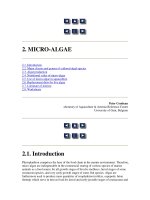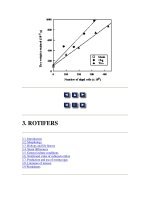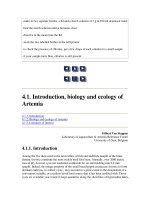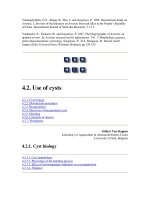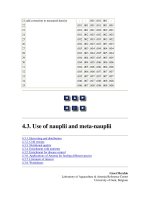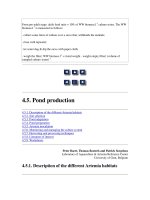Beneficial impact of Kisan credit card on crop production and productivity in selected districts of Haryana, India
Bạn đang xem bản rút gọn của tài liệu. Xem và tải ngay bản đầy đủ của tài liệu tại đây (153.27 KB, 5 trang )
Int.J.Curr.Microbiol.App.Sci (2020) 9(7): 3938-3942
International Journal of Current Microbiology and Applied Sciences
ISSN: 2319-7706 Volume 9 Number 7 (2020)
Journal homepage:
Original Research Article
/>
Beneficial Impact of Kisan Credit Card on Crop Production and
Productivity in Selected Districts of Haryana, India
Madhu Ahlawat and Sumita Singh*
Baba Mastnath University, Rohtak, Haryana 124021, India
*Corresponding author
ABSTRACT
Keywords
Production,
Productivity,
Farmer’s Income
Article Info
Accepted:
28 June 2020
Available Online:
10 July 2020
A field study was conducted during June 2019 to June 2020 at different locations of the
haryana district to find out the utilization pattern of kisan credit card by the farmers, to
analyze the constraints faced by the farmers while issuing of KCC and repayment of loan
and the strategies to overcome these constraints, to analyze the impact of KCC on the
enhancement in agricultural production. And to analyze the impact of KCC on the
enhancement of allied activities. Banks, branches and types of farmers (on the basis of
different classification such as age group, land holding, level of literacy, family type etc.),
agriculture are in the villages will be used as source of information and it will make three
stages of sample selection within the selected district (Rohtak). Rohtak district was
purposively selected for the research study due to varied climatic conditions and different
crop growing farmers were available as well as having good progress in implementing
KCC scheme. The results of the study reveals that KCC beneficiery farmers have obtained
higher production, productivity and net profit when compared with KCC non beneficiery
farmers.
Introduction
Agriculture sector is the mainstream of Indian
economy and the most important sector of the
Indian Economy When any change in the
agriculture sector-“positive or negative”- has
multiple effect on the entire economy
Therefore; the sustainable development of
agriculture is the most important for
acceleration in the Indian economy.
Agriculture development is influenced by
several factors like as irrigation, market,
infrastructure and credit. Out of these factors
credit is crucial input for sustainable
development of agriculture. Government of
India has been taken several steps in context
of agriculture credit. Kisan Credit Card is one
of them. S.Rajamohan and K.Subha (2014).
This scheme has facilitated the availability of
credit in time and has simplified the
procedure for availing loan from banks to a
large extent (Nahatkar et al., 2002).Credit is
an important component in agriculture with
crop loans constituting a major portion of
disbursements.
The Kisan Credit Card Scheme was
introduced in India in 1998- 99 by then
finance minister yashwant sinha. Kallur,
M.S. (2005). Consequent to this NABARD
3938
Int.J.Curr.Microbiol.App.Sci (2020) 9(7): 3938-3942
has prepared a model kisan credit card
scheme in consultation with the major banks
on the basis of R V GUPTA Committee.
Kisan credit card has emerged as a new and
vital delivery mechanism to meet the credit
requirements of the farmers in a suitable and
hassle free manner. The salient features of
KCC are as each farmer will be sanctioned a
revolving cash credit facility for meeting the
expenses related to crop cultivation allowing
any number of drawals and repayments within
the limit. The farmer is provided with a Kisan
Credit Card in the form of a passbook or an
identity card cum-pass book. The KCC is not
a electronic credit or debit card.The limit
under KCC will cover (a) entire production
credit needs for full year (on the basis of peak
crop credit requirement), (b) credit for
ancillary activities related to crop production
and allied activities, (c) credit needs of nonfarm activities, if any and (d) certain
percentage of production credit for
consumption purposes. The KCC to be valid
for 3 years subject to annual review by the
financing bank. The KCC holder may make
as any number of drawals and repayments in
the account as feasible. However each
drawal/disbursement to be repaid within 12
months. In case of damage to crops due to
occurrence of natural calamities, conversion /
re-scheduling of loans also permissible. If a
farmer cultivates Kharif crop and Rabi crop
peak credit requirement will be the sum of the
limits essential for the two seasons as the
costs of the Rabi crop would have started
much before the kharif crops are marketed. If
a farmer has Kharif, Rabi and Perennial crop
then the peak credit requirement will be
arrived on the basis of the projected cash
flows from farming operations. Notified crops
cultivated by the farmer with credit support
under KCC shall be covered by crop
insurance. Banks may make arrangement with
vendors to issue input on the basis of the KCC
and seek reimbursement from the bank.
The sustained and rapid growth in agriculture
can be achieved mainly through an increase in
productivity which is only possible through
provision of adequate and timely credit, on
the one hand, and accelerated development
and dissemination of improved technologies,
on the other (Singh, A and Sihag, S. (2018) In
order to produce more, the farmers need to
spend more on modem inputs, which must be
financed either out of savings or through
borrowings. Since the amount of savings by
the farmers is very poor, an increased
institutional credit flow is essential for faster
agricultural growth. Sharma (2006) revealed
that higher percentage 45.00 percent of the
respondents belonged to medium annual
income category. Sowjanya (2007) reported
that majority (57.14%) of the respondents
belonged to medium income groups, while
71.42 per cent of the respondents belonged to
low income category groups. Parmar (2008)
reported that a higher percentage of the
beneficiaries (43.33%) had medium level of
annual income. The net profit was 24120.11
per hectare in case of KCC beneficiaries and `
23551.34 per hectare in case of non-KCC
beneficiaries. Hooda, V.S. (2011).
Materials and Methods
The following stepwise procedure has been
done to carry our research
Study of background information of the
location
Banks, branches and types of farmers (on the
basis of different classification such as age
group, land holding, level of literacy, family
type etc.), agriculture are in the villages will
be used as source of information and it will
make three stages of sample selection within
the selected district (Rohtak). Rohtak district
was purposively selected for the research
study due to varied climatic conditions and
different crop growing farmers were available
as well as having good progress in
3939
Int.J.Curr.Microbiol.App.Sci (2020) 9(7): 3938-3942
implementing KCC scheme.
Sampling design: multistage sampling design
will be used for selection of sample for study.
The data will be collected with the help of
pre-tested questionnaires.
The problem of the area regarding KCC
Selection of samples:-
Processing of data
Primary Data
The basic information regarding the KCC's
collected through in-depth interview from the
by the help of Branch Manager and credit
manager.
Secondary Data
NABARD and other bank's financial reports
of last three years & Circulars of RBI
3) Variables used in study: the following
mentioned variables will be studied for easy
classification and understanding the cause of
the constraints of the KCC
Age
Education
Family background
Family type
Size of land holdings
Annual income
Attitude towards KCC`
Knowledge about KCC
editing: - to detect errors and omissions
coding and tabulation
categorization of data
Statistical tool: Mean, mode, percentage,
standard deviation, range, percentage share
and growth rate.
Results and Discussion
From the table 1, depicted above, it was
clearly found that farmers who had availed
KCC obtained higher gross reurn, family
labour income and ultimately net return in all
the crops. Also in the second table
productivity of the crops for KCC holders
farmers was found higher as compared to non
KCC farmers for all categories of farmers i.e.
small(<1 hactare), medium(1-2 hactare) and
large farmers (>2 hactares). In table 3 also the
similar trend was observed. Here we have
combined our sampling observations on all
categories of farmers for both KCC and non
KCC farmers.
Table.1 Returns over costs for KCC beneficiary and non KCC farmers in ROHTAK
Particulars
Small farmers
Beneficiery Farmer
90
Area
19.51
productivity
Non-Beneficiery Farmer
90
Area
17.8
productivity
9.61
% change in
productivity
Medium farmers
Large farmers
Total
90
19.97
90
20.6
270
20.02
90
18.16
9.97
90
19.4
6.19
270
18.82
8.59
3940
Int.J.Curr.Microbiol.App.Sci (2020) 9(7): 3938-3942
Table.2 Impact of Kisan Credit Card Scheme on Agricultural Production and Productivity of
Wheat Crop in District Karnal
Particulars
Gross Returns
Family Labour
Income
Net Return
Paddy
BENEFIC
IARY
24020
7516
8420
NONBEN.
21044
6209
Maize
BENEFI
CIARY
21536
6241
7158
6679
NONBEN.
19366
5678
Wheat
BENEFIC
IARY
21986
7244
6288
7211
NONBEN.
18876
5688
Potato
BENEFI
CIARY
56060
28233
NONBEN.
44836
15938
4218
26112
16522
Table.3 Comparison of productivity and returns before and after taking KCC
Parameters
Before taking KCC
Marginal farmers (0-2.5 acres)
40
Productivity (q./ha.)
51450.50
Gross income (Rs/ha.)
16302
Net income (Rs/ha.)
Small farmers (2.5-5 acres)
40.20
Productivity (q./ha.)
51707
Gross income (Rs/ha.)
16383.51
Net income (Rs/ha.)
Large farmers (>5 acres)
40.73
Productivity (q./ha.)
52389.47
Gross income (Rs/ha.)
16599.51
Net income (Rs/ha.)
In conclusion:The results of the study would be useful to the
farmers of ROHTAK in particular and
of HARYANA in general, identifying
the KCC scheme progress, impact,
utility, constraints at the farmer level.
The findings would be helpful to the farmers
for making appropriate decisions and
how best the available credit resources
could be judiciously utilized for
increased farm income.
This study would be useful for financial
institutes to assess the financial needs
of the farmers and their constraints in
availing loans.
At the micro level this study also guides the
farmers to depend upon financial
After taking KCC
43.50
68120.40
24800
43.70
68433.59
24914.02
44.00
68903.39
25085.05
sources of loans rather than noninstitutional sources and helpful to the
planners, administrators and research
workers for better planning and
implementation.
From this research the observed data could be
utilized to know the various constraints
responsible for the success of the KCC
The observed data will help in understanding,
what are the various changes that is
needed at credit institutional level for
the easy availment as well as repayment
of the loan.
Ultimately this research will be helpful in the
betterment of the farmers as a unit and
country as a whole.
3941
Int.J.Curr.Microbiol.App.Sci (2020) 9(7): 3938-3942
References
Hooda, V.S. (2011). Kisan Credit Card
Scheme:
A
Success
Story.
Kurukshetra. 59(8): 19 - 22.
Kallur, M.S. (2005), “Impact of Kisan Credit
Card on Flow of Credit and Repayment
Rate in a Backward Region : A case of
Agricultural Development Bank of
ShorapurTaluka, Gulbarga District,
Karnataka State,‟ Indian Journal of
Agricultural Economics. 60(3): 396
Nahatkar, S.B., Mishra, P.K., Raghuwanshi,
N.K. and Beohar, B.B. (2002) An
evaluation of
Kisan Credit Card
scheme: A case study of Patan tehsil of
Jabalpur district of Madhya Pradesh,
Indian Journal of Agricultural
Economics, 57(3): 578.
Parmar, S.K. (2008). A study on repayment
behaviour of beneficiaries of Kisan
Credit Card scheme in Sehore block of
Sehore district of Madhya Pradesh.
M.Sc. (Ag) Thesis submitted to
J.N.K.V.V. Jabalpur.
Rajamohan S and Mrs.K.Subha K. (2014).
Kisan Credit Card Scheme in India: a
Facet
of
Financial
Inclusion
International Journal of Scientific
Research. 3(10): 2277 – 8179
Sharma, S.K. (2006). A study on functioning
of Kisan Seva Kendras (KSKs) in
Udaipur district of Rajasthan. M.Sc.
(Agri.)
Thesis,
University
of
Agricultural Sciences, Dharwad.
Singh, A and Sihag, S. (2018). Impact of
kisan credit card scheme on farm
economy of farmers in karnal district
with special reference to wheat crop.
International educationa and research
journal, 4(5): 2454-9916.
Sowjanya (2007). A comparative analysis of
successful and unsuccessful selfhelp
groups in Gadag District of Karnataka.
M.Sc. (Agri.) Thesis, University of
Agricultural Sciences, Dharwad.
How to cite this article:
Madhu Ahlawat and Sumita Singh 2020. Beneficial Impact of Kisan Credit Card on Crop
Production and Productivity in Selected Districts of Haryana. Int.J.Curr.Microbiol.App.Sci.
9(07): 3938-3942. doi: />
3942

